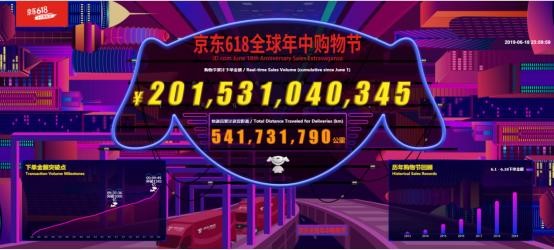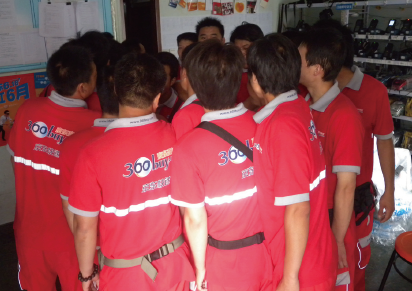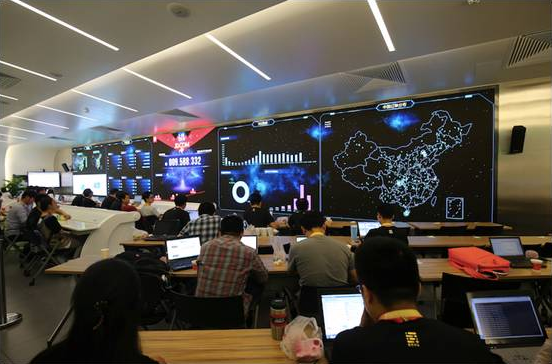Jun 8, 2020|
618: From JD.com’s Birthday to China’s Largest Mid-Year Shopping Carnival
by Yuchuan Wang
“During the COVID-19 epidemic, JD is the best retail platform in China and even in the whole world to support people’s livelihoods. As of this 618, we hope to continue our superb performance to benefit more consumers and our partners. ”
——Lei Xu, CEO of JD Retail
June 18th is JD.com’s birthday.
More than two decades ago, in 1998, 25-year-old Richard Liu committed RMB 12,000 yuan of his savings and leased a four-square-meter retail booth in Beijing’s technology hub of Zhongguancun. In a mall called “Haikai Market” (海开市场), he established JD Multimedia (京东多媒体), selling authentic-only laser products when many other peddlers haggling with customers and fake products were prevalent.
Today, not only has JD become China’s largest retailer, but the 618 promotion, named after June 18th to celebrate JD’s own anniversary, has turned into the largest nationwide mid-year shopping festival. It is joined by numerous e-commerce platforms and offline retail giants, and even catering and shopping establishments. It can be said that 618 has become one of the symbols of China’s rapid economic development.

618 in early days – an untended willow grows
When the SARS outbreak affected China in 2003, JD founder Richard Liu saw an opportunity, amid the challenges, to harness the potential of the Internet to support his business. In 2004, JD was moved online. June 18, 2004 is now considered JD’s first 618 promotion. Back then, the company launched flash sales to give back to its customers, charging just RMB 1 yuan for an RMB 100 yuan keyboard, for example.
At that time, discussion boards were the main channel for JD to communicate with its customers. Richard found that many customers would post shopping inquiries at night. Inspired by that, in 2005, JD launched a campaign in accordance with its anniversary period in June that offered big deals late at night for loyal customers. At the time, a large number of JD customers would postpone their shopping plans just to wait for JD’s anniversary celebration.
No doubt, JD has an obsession over customer experience. In order to deliver a superior shopping experience, JD started to build its in-house logistics network, managing every step of the supply chain, right through to the “last-mile” delivery. The unique retail + self-operated logistics model began to win over consumers. Although industry players and media criticized this “heavy” assets model at that time, customers knew where to find authentic products. They also knew JD was able to deliver the same or next day, something that no other platform can do. JD’s long-term persistence has led to its continued success: JD Logistics has become one of the most valuable properties of the e-commerce giant; and competitors building their own logistics arms were imitating JD’s business model.

With the completion of two rounds of financing in 2009, JD recruited a team of executives with professional backgrounds. Lei Xu, current CEO of JD Retail joined the company as the head of marketing. He is the third vice president of JD.
With Xu’s on-board, JD.com for the first time promoted 618 as a marketing concept on a large scale basis in 2009 and it saw an inspiring sales result: sales volume on June 18th surpassed RMB 30 million yuan, and the number of orders was over 45,000. That same year, Alibaba kicked off its first Single’s Day (also known as double 11 or 11.11) sales promotion on November 11th with 27 participating brands.
At the annual meeting in 2009, Richard Liu announced, “As of 6 pm, December 31, 2009, we have 2,206 employees.” The number was more than twice that of the previous year.
In 2011, JD extended the 618 promotion from a one-day event to a whole month celebration. At the same time, in addition to its traditional core category electronics, grocery, for the first time joined the promotion. Consumers spontaneously built a “618 shopping discussion” on Tianya Club, the most popular Chinese BBS in the 2000s, as well as the Douban and Weibo platforms, making 618 a heated topic among netizens. On June 18th 2011, JD’s sales volume exceeded RMB 200 million yuan, setting a record for daily sales of e-commerce in China. The innovative month-long promotion also brought greater impact to both consumers and China’s e-commerce industry.
As JD further introduced the books and apparel categories at its platform, competitors at that time, such as Tmall, SUNING, Quba and Dangdang, swarmed into the 618 battlefield in 2012. The addition of the JD Book business not only restrained Amazon and Dangdang, but also greatly reduced the threshold for new users to shop on JD.com, while the addition of apparel also stung some competitors.

Booming 618 – indispensable investment in technology
“At 11:59pm, my heart pounds violently.” Said Shang Xin, a senior director of JD Retail’s R&D team.
In the early morning of June 18, 2019, there were hundreds of R&D staffs at JD’s temporary tech preparation center designed specifically for 618, preparing for the most nervous moment of the year. Traffic reached its peak instantly at 00:00 and then stabilized gradually.
But 10 years ago, JD’s R&D was faced with unprecedented challenges for every big promotion. The challenges with technology infrastructure and traffic growth broke out in 2011. On June 18th, JD’s website crashed due to a sudden surge of orders. “We could do nothing but keep adding servers. Unfortunately, even adding three- or four-times the number of servers was useless. The situation lasted for seven or eight hours. Our R&D guys was completely lost.” Said Shang.
Zhai Songtao, from the JD-Y Smart Supply Chain business unit, remembers that “We were using an excel table to calculate sales predictions and purchasing amounts manually.” She continued, “At that time, none of our best sales managers could cover more than 2,000 SKUs (stock-keeping-units).” There are currently millions of first party (1P, referring to JD’s retail business model where it buys and stocks goods in its warehouses and delivers them to end customers) SKUs offered on JD.

The technical weakness threatened the reputation of JD’s user experience. The company immediately upgraded its tech architecture and planned for a middle-platform strategy to keep up with the fast-growing business scale.
JD’s sales managers are now empowered with big data and AI technologies that can help them predict sales, formulate price strategies and even promotion models automatically. The adoption of smart supply chain keeps improving JD’s operations efficiency. JD also shares its customer insights with brand owners and merchants, guiding their manufacturing and productions process and ultimately providing a superior user experience that enables customers to get the right product at the right time and right place. During last year’s 618, JD did not add a single server, not because the traffic growth was less, but because of its technological middle platform, which secures stable operations during the peak season.
In 2019, total investment by listed and unlisted affiliates of JD exceeded RMB 17.9 billion yuan (US$2.6 billion). JD’s technology investment is continuously improving the company’s operations efficiency, cost and user experience.
An open and inclusive 618
In 2014, JD.com became China’s first major e-commerce company to list on Nasdaq. 618 gradually became a brand asset under Lei Xu’s leadership as the marketing head. A 20-day celebration was formed and continues through today. The distribution of the sales over 20 days also helps relieve stress on customers, giving them more time to make purchases.
That year, JD announced it would welcome industry players to join the celebration. 618 ultimately became a national shopping carnival in China.
In 2017, JD advocated a “boundary-less retail” strategy and announced to further open 618 brand to any partners, and continued to build its technology and retail infrastructures. Brick-and-mortars began joining the “boundary-less retail alliance”. In 2018, over 500,000 offline stores participated in the 618 grand promotion, including offline supermarket giants Wal-Mart, Yonghui, BBK, Yintai and Rt-Mart.

In 2019, over 220,000 online merchants, millions of offline stores and over 5 million logistics and crowdsourcing service personnel in China contributed to JD’s 618. In the same year, Tmall announced it would participate in 618 with an unprecedented scale, and latecomer Pinduoduo also officially entered the big show.
This year, JD.com ushered in its 17th anniversary. Kicked off on June 1st, it is the first large nationwide shopping festival post-epidemic. The company announced it would have a sales promotion with the largest amount of discounts, the best shopping experience, the strongest brand growth opportunity, and the most new product launches ever.
Together, 618 and Singles’ Day form the mid-year and end-of-year peak. 618 witnessed the development of JD.com and JD.com has witnessed the trend of Chinese consumption. The rising number in transaction volume has embodied China’s vigorous growth online and offline.





 This Harbin tourism boom has also spurred a surge in sales of winter apparel. JD.com’s data indicates a rapid growth in the sales of warm clothing items such as down jackets, snow boots, and thermal underwear between January 1st and 7th. The sales growth is especially pronounced in southern provinces and cities such as Jiangsu, Zhejiang, Guangdong, Sichuan, and Shanghai. Notably, tall snow boots registered a 206% year-on-year increase in transactions, while padded cotton caps and thickened long down jackets soared by 158% and 134%, respectively. Beyond clothing, travel gear has also seen a considerable uptick, with a 98% year-on-year growth in transactions for large suitcases and travel backpacks in these southern regions.
This Harbin tourism boom has also spurred a surge in sales of winter apparel. JD.com’s data indicates a rapid growth in the sales of warm clothing items such as down jackets, snow boots, and thermal underwear between January 1st and 7th. The sales growth is especially pronounced in southern provinces and cities such as Jiangsu, Zhejiang, Guangdong, Sichuan, and Shanghai. Notably, tall snow boots registered a 206% year-on-year increase in transactions, while padded cotton caps and thickened long down jackets soared by 158% and 134%, respectively. Beyond clothing, travel gear has also seen a considerable uptick, with a 98% year-on-year growth in transactions for large suitcases and travel backpacks in these southern regions. Photo Gallery: This Week at JD (June 1-5)
Photo Gallery: This Week at JD (June 1-5)



